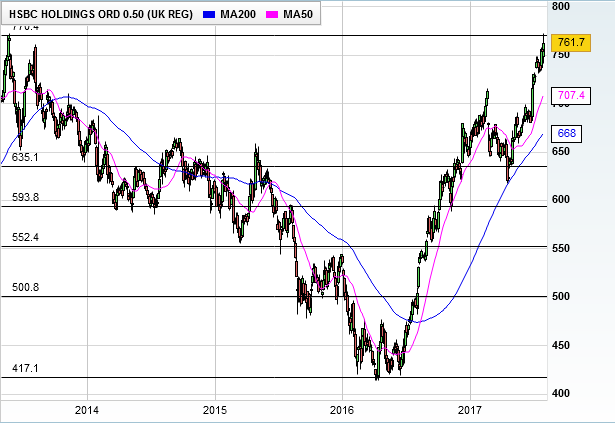Here's why HSBC just surged to a four-year high
31st July 2017 10:06
by Graeme Evans from interactive investor
Share on
put on a show of financial strength Monday by revealing its third share buy-back in a year and releasing interim results ahead of expectations.
As well as the further buy-back of $2 billion (£1.5 billion), HSBC said it had paid more in dividends than any other European or American bank in the past 12 months. "Where we have excess capital, we are open to returning it to shareholders," said chief executive Stuart Gulliver.
The latest buy-back brings the total value of shares repurchased since August 2016 to $5.5 billion, having announced a buy-back of $1 billion in the spring.
Jason Napier, analyst at UBS, expects a further $2 billion buy-back will be announced at third-quarter results due in October.
HSBC said shareholders were now reaping rewards from the repositioning of the group since 2011, with most of the targets set out in a 2015 strategy update now met.
Shares improved 4% Monday morning to 772p, half a penny shy of a previous hgh set in late May 2013.

Europe's biggest bank has scaled back its global footprint to 67 countries and territories, from 73 at the end of 2014, while it has achieved its target of more than $4.5 billion in cost savings and a reduction in risk weighted assets (RWAs) of $290 billion.
Shares have made steady progress since this time last year, with the stock up 54% since August 2016 and 13% stronger for 2017 so far.
Adjusted profits of $12 billion for the half-year were 12% higher than a year earlier and better than analysts' expectations. As forecast, the dividend for the first half of the year will be $0.20, amounting to $4 billion in total.
HSBC said the increased shareholder pay-outs were achieved whilst also "strengthening one of the most resilient capital ratios in the industry."
The bank's common equity tier 1 ratio, which is critical to its capacity to sustain its dividend, was 14.7% at 30 June, up from 12.1% at the same point in 2016 and ahead of UBS' estimates for 14.4%.
It removed a further $29 billion in RWAs from the balance sheet in the first half of 2017, meaning it has extracted a total of $296 billion of RWAs from the business since the start of 2015, comfortably exceeding its target.
HSBC said it continues to shift the business mix towards Asia, with its loan portfolio in the region growing by $31 billion over the half year to $401 billion.
Last year, HSBC removed a timetable for reaching its 10% return on equity (ROE) target. This has now become a medium-term target, with the bank reporting a ratio of 8.8% for the half year, compared with 7.4% a year earlier.
Ian Gordon, analyst at Investec, says: "After allowing for the benefit from usual seasonality within this outturn, we still struggle to see HSBC achieving more than 10% ROE before 2020."
This article is for information and discussion purposes only and does not form a recommendation to invest or otherwise.The value of an investment may fall. The investments referred to in this article may not be suitable for all investors, and if in doubt, an investor should seek advice from a qualified investment adviser.